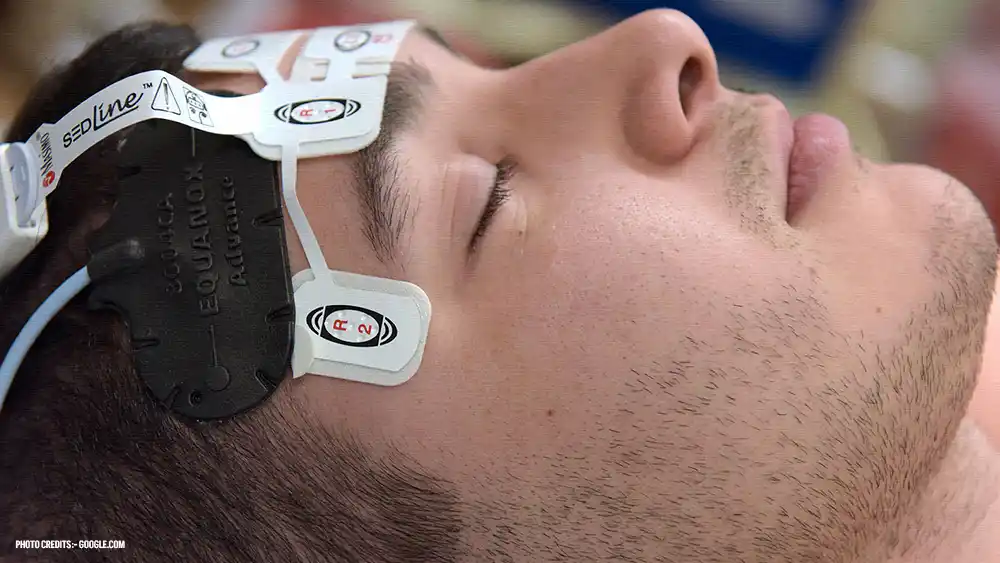
NEUROSCIENCE
Brain Oxygenation: How Long Can the Brain Go Without Oxygen?
-
 Rahul Priydarss
Rahul Priydarss - April 30, 2024
Discover the critical role of oxygen in brain function and the consequences of oxygen deprivation in this comprehensive article. From understanding brain oxygenation to exploring survival stories and treatment options, delve into the intricate mechanisms of brain resilience and vulnerability. Learn about the timeline of brain damage, factors affecting tolerance to oxygen deprivation, and essential interventions for mitigating risks. Gain insights into the limits of human endurance and the potential for recovery, underscoring the importance of prompt medical attention and proactive measures in safeguarding brain health.
Introduction:
The brain can only survive for a brief period without oxygen. After about 4 to 6 minutes without oxygen, irreversible damage can occur. This is because brain cells are susceptible to oxygen deprivation and begin to die off rapidly without a constant supply of oxygen. However, the exact time frame can vary depending on factors such as age, overall health, and the cause of oxygen deprivation. Immediate medical attention is crucial in cases of oxygen deprivation to prevent permanent brain damage or death.
What is Brain Oxygenation:
The human brain is a marvel of complexity, orchestrating everything from the flick of a finger to the symphony of thoughts and emotions that define us. But this intricate dance requires a constant flow of fuel – oxygen. Unlike muscles that can store energy, brain cells are oxygen guzzlers, consuming 20% of the body’s total oxygen supply despite only making up 2% of our weight. Let’s delve deeper into the fascinating world of brain oxygenation, exploring the journey of oxygen, its critical role, and the factors that influence this vital process.

Table of Contents
The Breath of Life: Our adventure begins with inhalation. Air, rich in oxygen, enters the lungs through the respiratory system. Here, gas exchange takes place. Oxygen diffuses from the air sacs (alveoli) in the lungs into the bloodstream, while carbon dioxide, a waste product of cellular respiration, makes the return journey for exhalation.
Highways of the Body: Oxygenated blood embarks on a journey through the body’s intricate network of arteries. Key players in this delivery system are the carotid arteries, located on either side of the neck, and the vertebral arteries, which wind their way up the spine. These vessels converge to form a circle of arteries at the base of the brain, ensuring a robust supply of oxygen-rich blood.
The Selective Gatekeeper: The brain is a privileged guest, protected by a highly specialized barrier known as the blood-brain barrier (BBB). This selective gatekeeper meticulously regulates the passage of substances between the bloodstream and the delicate brain tissue. Only essential molecules and nutrients, like oxygen, are granted access, while harmful substances are kept at bay.
Microscopic Delivery System: Once past the BBB, the oxygenated blood reaches a vast network of microscopic blood vessels called capillaries. These capillaries have incredibly thin walls, allowing for the efficient diffusion of oxygen directly into the brain cells (neurons) surrounding them.
Fueling the Neural Fire: Finally, oxygen reaches its destination – the brain cells. Here, it participates in a cellular powerhouse process called cellular respiration. During this process, oxygen combines with glucose (sugar) to generate energy (ATP) that fuels all brain functions, from the spark of an idea to the intricate coordination of movement.
The brain is the most oxygen-hungry organ in the body. It relies on a constant supply of oxygen to function properly. Brain cells are very sensitive to a lack of oxygen, and they begin to die within minutes if deprived.
Effects of Oxygen Deprivation on the Brain:
Oxygen deprivation, also known as hypoxia or anoxia, can have severe effects on the brain due to its high metabolic demands and sensitivity to changes in oxygen levels. When the brain is deprived of oxygen, even for a short period, it can lead to various adverse effects.
Cognitive Impairment: Oxygen deprivation can impair cognitive functions such as memory, attention, and decision-making. This can manifest as confusion, disorientation, or difficulty in performing tasks that require mental clarity.
Loss of Consciousness: Severe oxygen deprivation can cause loss of consciousness or even coma. This occurs when brain function is significantly impaired due to a lack of oxygen.
Brain Damage: Prolonged oxygen deprivation can result in irreversible damage to brain cells. Neurons are particularly vulnerable to oxygen deprivation, and if deprived of oxygen for too long, they can die off, leading to brain damage. This damage can manifest as motor deficits, speech impairment, or other neurological abnormalities.
Neurological Disorders: Chronic or repeated episodes of oxygen deprivation may increase the risk of developing neurological disorders such as epilepsy, Alzheimer’s disease, or Parkinson’s disease. The brain’s susceptibility to damage from oxygen deprivation makes it more vulnerable to long-term neurological complications.
Death: In extreme cases, prolonged oxygen deprivation can lead to brain death, where the brain irreversibly loses all function. Without oxygen, the brain cannot sustain its vital functions, leading to systemic failure and eventual death.
Factors Affecting Brain’s Tolerance to Oxygen Deprivation:
The brain’s tolerance to oxygen deprivation can vary depending on several factors.
Duration of Deprivation: The length of time the brain is deprived of oxygen is a crucial factor. Short periods of oxygen deprivation may be tolerated better than prolonged deprivation. Rapid intervention to restore oxygen supply can minimize damage during brief episodes of hypoxia.
Severity of Deprivation: The extent to which oxygen levels drop below normal can significantly impact the brain’s tolerance. Mild or moderate hypoxia may result in reversible effects, while severe hypoxia can cause irreversible damage within a short period.
Age: The brain’s tolerance to oxygen deprivation may vary with age. In general, younger individuals tend to have greater resilience to hypoxia compared to older adults. Aging can lead to changes in brain structure and function, reducing the brain’s ability to withstand oxygen deprivation.
Overall Health: The brain’s tolerance to oxygen deprivation is influenced by the individual’s overall health status. Pre-existing medical conditions such as cardiovascular disease, respiratory disorders, or neurological conditions can affect the brain’s ability to cope with reduced oxygen levels.
Preconditioning: Some individuals may experience preconditioning, where exposure to mild or intermittent hypoxia induces protective mechanisms in the brain. This preconditioning can enhance the brain’s tolerance to subsequent episodes of oxygen deprivation.
Temperature: Body temperature can influence the brain’s response to hypoxia. Hypothermia, or lowered body temperature, can slow metabolic processes and reduce oxygen demand, potentially prolonging the brain’s tolerance to oxygen deprivation.
Genetic Factors: Genetic variations may play a role in determining an individual’s susceptibility to oxygen deprivation. Certain genetic traits or mutations may affect the brain’s ability to adapt to low-oxygen environments or mitigate the effects of hypoxia.
Prior Oxygen Levels: The baseline level of oxygen saturation in the blood and tissues can influence the brain’s response to oxygen deprivation. Individuals with higher baseline oxygen levels may have a greater buffer against hypoxia compared to those with lower baseline oxygen levels.

How Long Can the Brain Go Without Oxygen:
The human brain is a marvel of efficiency, constantly buzzing with electrical activity that underpins everything we do, from the flutter of a heartbeat to the spark of an idea. But this intricate dance is fueled by a constant supply of oxygen. Unlike muscles that can store energy for short bursts, brain cells are oxygen-obligated, meaning they require a continuous stream of oxygen to function and survive.
Let’s delve into the cellular countdown that unfolds when the brain is deprived of oxygen, exploring the chain of events that lead to cell death and potential brain damage.
The Domino Effect: A Step-by-Step Breakdown:
The Oxygen Shortage: The initial insult is a disruption in oxygen supply. This can happen due to various reasons, such as choking, cardiac arrest, stroke, or even severe respiratory problems.
Energy Crisis: With no incoming oxygen, brain cells can no longer participate in cellular respiration, the process by which they generate energy (ATP) from glucose (sugar) and oxygen. This vital energy source fuels all cellular functions, including maintaining ion gradients across the cell membrane, which is crucial for proper nerve signaling.
ATP Depletion: As cellular respiration grinds to a halt, ATP levels within the brain cell rapidly deplete. This disrupts essential cellular processes like protein synthesis and the maintenance of cellular structures.
Ionic Chaos: The lack of ATP also disrupts the delicate balance of ions (charged particles) across the cell membrane. This imbalance leads to a phenomenon called excitotoxicity, where excessive levels of excitatory neurotransmitters flood the synapse, overstimulating neighboring neurons and causing them to fire uncontrollably.
Free Radical Frenzy: Oxygen deprivation also triggers the production of free radicals, highly reactive molecules that damage cellular components like proteins, lipids, and DNA. These free radicals act like microscopic vandals, wreaking havoc on the delicate machinery within the brain cell.
Mitochondrial Dysfunction: Mitochondria, the powerhouses of the cell, are particularly vulnerable to oxygen deprivation. They not only require oxygen for ATP production but also suffer damage from free radicals released during this process. This further cripples cellular energy production and worsens the situation.
Apoptosis Cascade: If oxygen deprivation persists, brain cells eventually enter a programmed cell death pathway called apoptosis. This carefully orchestrated suicide ensures the removal of damaged cells and prevents further harm to surrounding tissue.
The Timeline of Brain Damage:
The brain is incredibly sensitive to oxygen deprivation. While the exact tolerance can vary depending on individual factors, brain cells begin to die within minutes if completely cut off from oxygen. Here’s a closer look at the critical timeline.
30 seconds to 3 minutes: During this initial period, you might experience symptoms like dizziness, confusion, and loss of coordination as the brain struggles to maintain function with dwindling ATP levels.
1 minute: This is the critical time mark where brain cells, particularly vulnerable ones like hippocampal neurons involved in memory, start succumbing to apoptosis due to lack of oxygen and energy.
3 minutes: At this point, neuronal damage becomes more extensive, with excitotoxicity and free radical damage playing a significant role. The chances of permanent brain damage increase significantly if the oxygen supply isn’t restored.
5 minutes: Brain function deteriorates rapidly. Loss of consciousness and coma can set in as a large number of brain cells succumb to cell death.
10 minutes: Even if survival occurs, coma and severe brain damage are almost inevitable due to widespread cell death throughout the brain.
15 minutes: Survival becomes highly unlikely at this stage due to extensive neuronal death and brain dysfunction.
Factors Affecting Vulnerability:
It’s important to remember that this is a general timeline, and individual tolerance can vary depending on several factors.
Age: Children and older adults are generally more susceptible to brain damage from oxygen deprivation compared to young adults. This is partly due to differences in brain development and metabolic rates.
Overall Health: Underlying health conditions like heart disease, stroke, or chronic respiratory problems can further decrease the brain’s tolerance to oxygen deprivation.
Body Temperature: Hypothermia can offer some protection. By lowering body temperature, the metabolic rate slows down, reducing the brain’s need for oxygen. This technique is sometimes used during certain surgeries to protect the brain.
Survival Stories and Limits:
Survival stories involving periods of oxygen deprivation can be both remarkable and informative about the limits of human endurance. Here are a few notable examples.
Anna Bågenholm: In 1999, Anna Bågenholm, a Swedish radiologist, survived being trapped under ice in freezing water for 80 minutes after a skiing accident. She was trapped in a semi-submerged position, which slowed her body’s metabolism and oxygen consumption, helping to prolong her survival despite extreme hypothermia and oxygen deprivation. Remarkably, she was successfully resuscitated and made a near-full recovery, with only minor long-term complications.
Harrison Okene: In 2013, Harrison Okene, a Nigerian cook, survived for almost three days in the air pocket of a sunken tugboat at the bottom of the ocean after it capsized. Despite being in complete darkness and extreme cold, Okene managed to conserve oxygen by staying still and breathing from an air pocket. He was eventually discovered by a rescue team and brought to safety in a remarkable tale of survival against all odds.
Martin Pistorius: Martin Pistorius, a South African man, fell into a coma-like state at the age of 12 due to a mysterious illness. For 12 years, he was trapped in a vegetative state, unable to move or communicate, but fully conscious. Despite the lack of oxygen reaching his brain during this time, Pistorius eventually began to regain consciousness and awareness, defying medical expectations. His story highlights the complex nature of brain function and the potential for unexpected recovery even after prolonged periods of oxygen deprivation.
Treatment for oxygen deprivation:
Treatment for oxygen deprivation depends on the cause, severity, and duration of the deprivation. Here are some common approaches.
Oxygen Therapy: The primary treatment for oxygen deprivation is to restore oxygen supply to the body and brain. This can be done through oxygen therapy, where the patient receives supplemental oxygen through a mask or nasal cannula. Increasing the concentration of oxygen in the blood can help compensate for reduced oxygen levels and prevent further damage to the brain and other organs.
Resuscitation: In cases of sudden cardiac arrest or respiratory failure leading to oxygen deprivation, immediate resuscitation measures are essential. This may include cardiopulmonary resuscitation (CPR) to maintain blood circulation and artificial ventilation to provide oxygen to the lungs.
Mechanical Ventilation: For patients who are unable to breathe adequately on their own, mechanical ventilation may be necessary to support respiratory function and ensure sufficient oxygenation of the blood.
Medications: In some cases, medications may be administered to treat underlying conditions contributing to oxygen deprivation, such as bronchodilators for asthma or antibiotics for pneumonia. Medications to support blood pressure and cardiac function may also be used to maintain adequate perfusion of oxygen to vital organs.
Hyperbaric Oxygen Therapy (HBOT): Hyperbaric oxygen therapy involves breathing pure oxygen in a pressurized chamber, which allows the lungs to absorb higher concentrations of oxygen and deliver it to tissues throughout the body. HBOT is sometimes used as an adjunctive treatment for conditions involving tissue hypoxia, such as carbon monoxide poisoning or certain types of wounds.
Treatment of Underlying Causes: Addressing the underlying cause of oxygen deprivation is crucial for effective treatment. This may involve interventions such as clearing airway obstructions, treating respiratory infections, correcting heart rhythm abnormalities, or managing conditions like stroke or heart attack.
Neurorehabilitation: For individuals who experience neurological deficits as a result of oxygen deprivation, neurorehabilitation programs may be beneficial. These programs aim to improve cognitive function, motor skills, and overall quality of life through physical therapy, occupational therapy, speech therapy, and other interventions.
FAQs about Brain Oxygenation:
A1: During oxygen deprivation, brain cells switch to anaerobic metabolism, leading to biochemical imbalances, neuronal dysfunction, and, ultimately, cell death.
A2: While some degree of recovery is possible with timely intervention and rehabilitation, the extent of regeneration depends on the severity and duration of oxygen deprivation.
A3: Warning signs of oxygen deprivation include confusion, dizziness, shortness of breath, cyanosis (bluish discoloration of the skin), and loss of consciousness.
A4: Hypoxia refers to reduced oxygen supply to tissues, whereas anoxia denotes a complete absence of oxygen. Both conditions can lead to cellular dysfunction and tissue damage.
A5: While some degree of recovery is possible, particularly with prompt intervention, severe and prolonged oxygen deprivation often results in irreversible brain damage.
-Please remember, to always consult with healthcare professionals or Doctors for personalized advice related to medical conditions.
Conclusion:
In conclusion, the brain’s survival without oxygen is limited, typically lasting only 4 to 6 minutes before irreversible damage occurs. Factors like age, health, and the cause of deprivation can influence this timeframe. Immediate medical attention is crucial to prevent permanent brain damage or death. Understanding brain oxygenation, the effects of deprivation, and treatment options is essential for mitigating risks and optimizing outcomes in cases of oxygen deprivation. Through remarkable survival stories and medical interventions, we gain insights into the limits of human endurance and the potential for recovery even in dire circumstances.




